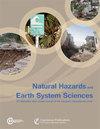分析全球范围内监测人类供水和河流生态系统干旱危害的替代危害指标的信息价值
IF 4.7
2区 地球科学
Q1 GEOSCIENCES, MULTIDISCIPLINARY
引用次数: 1
摘要
摘要径流干旱危害指标(SDHI)大多缺乏大规模干旱预警系统(DEWS)。本文提出了一种选择和计算SDHI的新系统方法,用于监测地表水和河流生态系统的人类供水干旱。在选择指标时,我们建议考虑风险系统(例如,特定地区的供水商或小规模农民)对径流制度的习惯性;即,DEWS的用户应该确定感兴趣的风险系统已经习惯并适应了哪种偏离正常值的类型(例如,某个年际变化或某个相对流量减少)。区分四种指标类型,我们对干旱程度(预定义时期内的水分异常)和严重程度(自干旱事件发生以来的累积程度)的指标进行了分类,并指定了计算SDHI时需要做出的许多相关决策。使用全球水文模型WaterGAP 2.2d,我们量化了全球8个现有和3个新的SDHI。对于基于水文模型输出的大规模DEWS,我们建议特定的SDHI适用于评估(1)河流生态系统、(2)无法进入大型水库的用水者和(3)有大型水库的用水者的干旱危害,并适用于通知水库管理者。这些SDHI包括干旱程度和严重性指标,这些指标因时间平均期和风险系统对水资源可用性降低的适应程度而不同。根据风险系统的习惯,干旱程度最好通过与平均值的相对偏差来量化,或者通过基于不超标频率的流量值的重现期来量化。为了计算重现期,我们倾向于经验百分位数而不是标准化的流量指标,因为前者由于拟合概率分布而不存在不确定性,并且可以针对所有流量时间序列进行计算。干旱严重程度应使用指标进行评估,这些指标意味着对一定程度的年际变化的适应,以确保平均流量的减少,以及满足人类用水需求和环境流量的能力。储层管理者最好通过表示流入储层的网格单元的SDHI获得信息。DEWS必须就所提供的指标对特定风险系统的适用性提供全面而明确的解释。本文章由计算机程序翻译,如有差异,请以英文原文为准。
Analyzing the informative value of alternative hazard indicators for monitoring drought hazard for human water supply and river ecosystems at the global scale
Abstract. Streamflow drought hazard indicators (SDHIs) are mostly lacking in
large-scale drought early warning systems (DEWSs). This paper presents a new
systematic approach for selecting and computing SDHIs for monitoring drought
for human water supply from surface water and for river ecosystems. We
recommend considering the habituation of the system at risk (e.g., a
drinking water supplier or small-scale farmers in a specific region) to the
streamflow regime when selecting indicators; i.e., users of the DEWSs should
determine which type of deviation from normal (e.g., a certain
interannual variability or a certain relative reduction of streamflow) the
risk system of interest has become used to and adapted to. Distinguishing four
indicator types, we classify indicators of drought magnitude (water anomaly
during a predefined period) and severity (cumulated magnitude since the
onset of the drought event) and specify the many relevant decisions that
need to be made when computing SDHIs. Using the global hydrological model
WaterGAP 2.2d, we quantify eight existing and three new SDHIs globally. For
large-scale DEWSs based on the output of hydrological models, we recommend
specific SDHIs that are suitable for assessing the drought hazard for (1) river ecosystems, (2) water users without access to large reservoirs, and (3) water users with access to large reservoirs, as well as being suitable for
informing reservoir managers. These SDHIs include both drought magnitude and
severity indicators that differ by the temporal averaging period and the
habituation of the risk system to reduced water availability. Depending on
the habituation of the risk system, drought magnitude is best quantified
either by the relative deviation from the mean or by the return period of
the streamflow value that is based on the frequency of non-exceedance. To
compute the return period, we favor empirical percentiles over the
standardized streamflow indicator as the former do not entail uncertainties
due to the fitting of a probability distribution and can be computed for all
streamflow time series. Drought severity should be assessed with indicators
that imply habituation to a certain degree of interannual variability, to a
certain reduction from mean streamflow, and to the ability to fulfill human
water demand and environmental flows. Reservoir managers are best informed
by the SDHIs of the grid cell that represents inflow into the reservoir. The
DEWSs must provide comprehensive and clear explanations about the suitability
of the provided indicators for specific risk systems.
求助全文
通过发布文献求助,成功后即可免费获取论文全文。
去求助
来源期刊
CiteScore
7.60
自引率
6.50%
发文量
192
审稿时长
3.8 months
期刊介绍:
Natural Hazards and Earth System Sciences (NHESS) is an interdisciplinary and international journal dedicated to the public discussion and open-access publication of high-quality studies and original research on natural hazards and their consequences. Embracing a holistic Earth system science approach, NHESS serves a wide and diverse community of research scientists, practitioners, and decision makers concerned with detection of natural hazards, monitoring and modelling, vulnerability and risk assessment, and the design and implementation of mitigation and adaptation strategies, including economical, societal, and educational aspects.

 求助内容:
求助内容: 应助结果提醒方式:
应助结果提醒方式:


